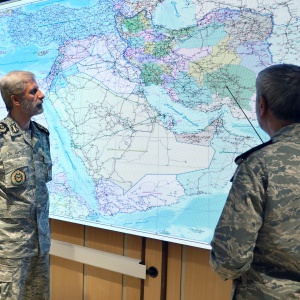Opinion: War devastates lives — and the environment, too

Flying a bare 100 feet above the jungle hills west of Hue, Vietnam, 5 bulky 'C-123 providers' cut loose a spray of chemical defoliant on August 14, 1968. The chemicals used burn off heavy foliage hiding enemy infiltrations routes and base camps. The aircraft are specially equipped with huge 1,000 gallon tanks holding 11,000 lbs. of herbicide. To hit their target areas they fly barely above the tree tops and in tight formation. Robert Ohman
| Published: 05-29-2025 11:00 AM |
Scott Dickman is a board member of New Hampshire Peace Action and belongs to the Compassionate Listening Project. He lives in Concord.
A member of New Hampshire Peace Action’s Board, when I volunteered to write this essay on the intersection of militarism and the environment, I intended an analytical litany of war’s devastating consequences to the environment.
Fortunately, a lapse of several days intervened between this commitment and a visit with my grandson, when we played together in search of ants and bugs. The experience reminded me of author and scientist Robin Wall Kimmerer’s observations, emphasizing rekindling relationships with the natural world, that plants, animals, land and humans are an intertwined web of relationships.
In that moment, our hands muddied, I understood what my intended technical research would miss — the bond between humanity and nature isn’t merely ecological, it is sacred. Walking hand in hand, how could I not be concerned about the world my grandson will inherit? And what better time to address this issue than after Earth Day, which marked the anniversary of the birth of the modern environmental movement in 1970?
With my task now reframed, history confirms that war devastates the environment on a massive scale, extending far beyond human tragedy. It scars the Earth in ways that endure long after peace treaties are signed, leaving a legacy my grandchildren and theirs will inherit, even after the reasons for conflict have faded from memory.
War is brutal. It devastates landscapes, pollutes ecosystems, and causes long-term damage to the delicate balance of nature. While the human cost is staggering, the environmental repercussions are significant and deserve our attention. The following examples illustrate how conflict affects not only the natural world but the vital economic and political web of shared global interests.
During the Vietnam War (1965-1975), the U.S. deployed Agent Orange to clear forests sheltering enemy forces, impacting millions of acres of land, contaminating soil and water and causing severe health issues, including cancer and birth defects. Decades later, these areas still struggle to recover.
As the Gulf War (1990-1991) ended, retreating Iraqi forces set over 600 oil wells ablaze, polluting the air while deliberate oil spills dumped millions of barrels into the Persian Gulf, devastating marine ecosystems and underscoring how environmental sabotage leaves destruction long after the fighting stops.
Article continues after...
Yesterday's Most Read Articles
During the Iraq War (2003-2011), extensive contamination from depleted uranium munitions precipitated elevated rates of high birth defects and cancer. Interdisciplinary research in Fallujah, Iraq, concluded that people returning to bombarded homes and neighborhoods faced a 17-fold increase in birth anomalies and myriad other health problems from heavy metal exposure from the 2003 U.S. invasion.
The ongoing conflict in Ukraine (2022–present) highlights the environmental toll of modern warfare, which has led to chemical spills, water contamination, ecosystem disruption and threatened biodiversity. Fires from bombed-out buildings and fuel depots have precipitated a surge in greenhouse gas emissions, and continued attacks on the Zaporizhzhia Nuclear Power Station threaten a nuclear disaster.
More broadly, the U.S. military is one of the largest institutional consumers of fossil fuels, with massive carbon emissions worsening global warming and threatening environmental sustainability. NATO has estimated 110 million unexploded landmines contaminating nearly 70 countries and territories today, posing a significant threat to civilians, as an estimated 5,544 people are killed or maimed annually.
On April 7, NH Peace Action hosted Dr. Kali Rubaii of Purdue University. She addressed research that suggests militaries account for up to 5.5% of total global greenhouse gas emissions.
War disrupts conservation efforts and worsens existing environmental problems. National parks and wildlife reserves become battlegrounds, leading to habitat destruction and biodiversity loss. During the Rwandan Civil War in the 1990s, large numbers of refugees settled in protected areas, cutting down trees for fuel and clearing land for temporary shelter, causing irreversible damage to ecosystems that housed endangered species.
Despite the grim reality, international organizations and governments can enforce laws prohibiting environmental destruction during conflicts. Post-war recovery should go beyond rebuilding infrastructure to include reforestation and pollution cleanup. Importantly, raising awareness of war’s ecological costs can also rally public support for peaceful resolutions.
In closing, I hope to instill in my grandchild — and, through him, in future generations — a deep appreciation of nature and wonder and a strong sense of stewardship for the Earth, our only home. Shouldn’t the legacy we leave our grandchildren be a world worthy of their dreams and aspirations? Unhesitatingly, “Yes!”







 Opinion: Trumpism in a dying democracy
Opinion: Trumpism in a dying democracy Opinion: What Coolidge’s century-old decision can teach us today
Opinion: What Coolidge’s century-old decision can teach us today Opinion: The art of diplomacy
Opinion: The art of diplomacy Opinion: After Roe: Three years of resistance, care and community
Opinion: After Roe: Three years of resistance, care and community
